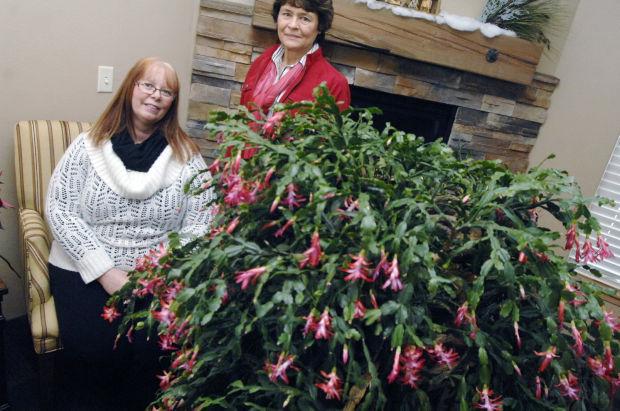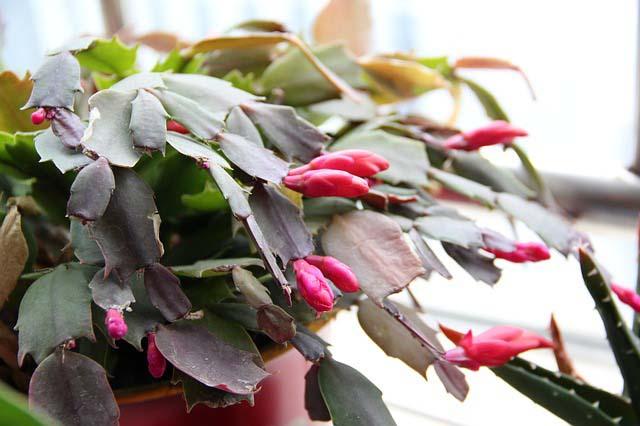Posted by Beth on Wednesday, Mar 29, 2017
Sometimes we get questions at the Information Desk that sound more complicated than they really are. This weeks stumper was "Why is my Christmas Cactus blooming in March?" This actually has a very simple answer: Because it's not a Christmas Cactus - it's an Easter Cactus.

Most people see this plant and think Christmas Cactus. Late in the year you can find them anywhere - from grocery stores to big box stores - in shades of pink, red or even white.
"Christmas Cactus" has become a generic term for three different cacti in the same family. What most people think of as "Christmas Cactus" will turn out to be either a Thanksgiving Cactus, a Christmas Cactus, or an Easter Cactus. How to can you tell the difference? Is it blooming now? What month is it? Is it early November, late December, or late winter/early spring? That can give you a big hint. But the real way to tell them apart is to look closely at the leaves.

All three plants have fleshy flat leaf sections. Thanksgiving cactus leaves have longer, curved projections along the edge. The Christmas cactus have smaller more right angle-like projections, and the Easter cactus have no projects, just gently scalloped leaf edges. These cacti are members of the the Schlumbergera genius of cacti (although Easter cactus has multiple accepted names: Schlumbergera gaertneri, Phipsalidopsis gaertnerii, Rhipsalidopsis gaetneri or Hatiora gaetneri). All three are native to the forests of Brazil.
 These cactus can be incredibly long lived, often being passed down from one generation to the next in families. This picture is from a story in the Bismarck Tribune about one family's 111-year-old cactus. There was a news story about a 145 year old cactus belonging to a family in Bozeman, Montana, and Writer Ann Parr wrote about her family's 150+ year old cactus.
These cactus can be incredibly long lived, often being passed down from one generation to the next in families. This picture is from a story in the Bismarck Tribune about one family's 111-year-old cactus. There was a news story about a 145 year old cactus belonging to a family in Bozeman, Montana, and Writer Ann Parr wrote about her family's 150+ year old cactus.
The common name "Christmas Cactus" is misleading. These plants are not sun loving, drought tolerant cacti. Being native to the treetops of the coastal mountain ranges of Brazil they like bright but filtered sunlight and regular watering so that their potting material does not dry out completely. They are happiest when they are pot-bound, which makes them even easier to care for - no repotting.
Once the flowers fade, they should be treated like a houseplant. Place them in bright light, but not direct sunlight, and water regularly. They can be grown outside during the summer as long as their pots are placed in dappled shade, they are watered regularly, and are brought back inside before nighttime temperatures hit 50 degrees Fahrenheit. Fertilize once a year in late spring or early Summer and you'll have a healthy happy plant.
The most common question people have about Christmas Cactus is how to get them to rebloom after the first year. Blooms requires two things: cooler temperatures and long nights. These cacti are short-day plants, which means that blooms are triggered by long dark cool nights. They need between 14-16 hours of uninterrupted darkness and 8 hours of daylight for between 3 - 6 weeks to set flower buds. Streetlights and indoor lights will disrupt their required darkness cycle, so you can either cover them each night with a black garbage bag, or find a room in your house that is seldom used at night and place them near a window. If the temperatures in the room are a bit cooler it will be even better. Their desired night time temperature is between 50 and 68 degrees. Once flower buds appear along the leaf ends you can move the plant back to its regular place in your home to enjoy the flowers.
 Be careful about placing them in drafts. Drafts may cause bud drop. A few buds dropping off is normal, but drafts will cause the plant to drop all its buds at once - then you'll be out of luck for another year.
Be careful about placing them in drafts. Drafts may cause bud drop. A few buds dropping off is normal, but drafts will cause the plant to drop all its buds at once - then you'll be out of luck for another year.
Reiman Gardens at Iowa State University has a nice downloadable brochure about the care and propagation of Holiday Cactus that you can download for free here.


Added by Beth